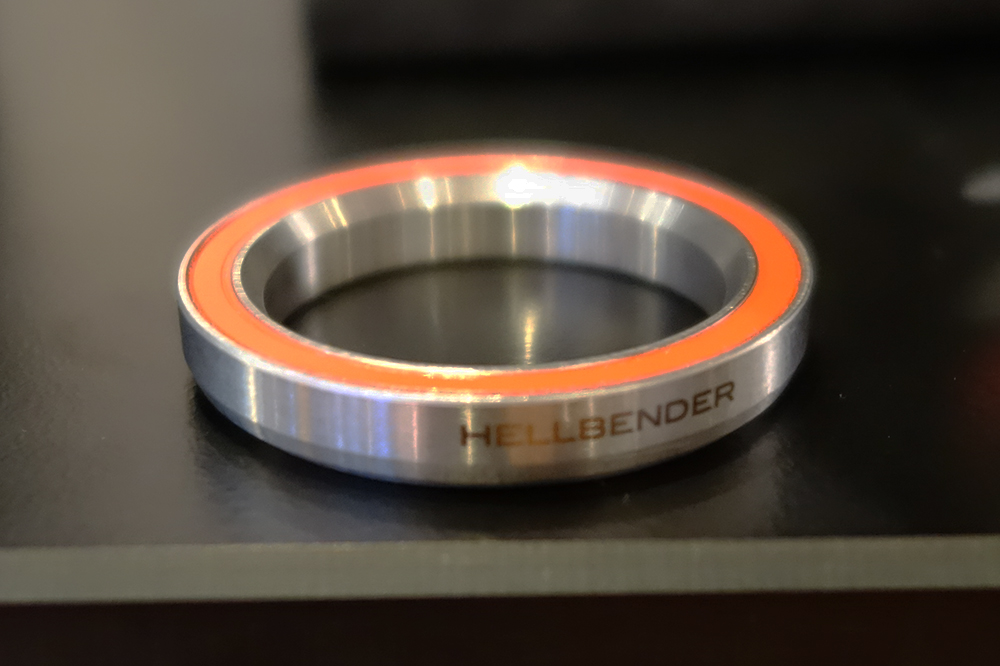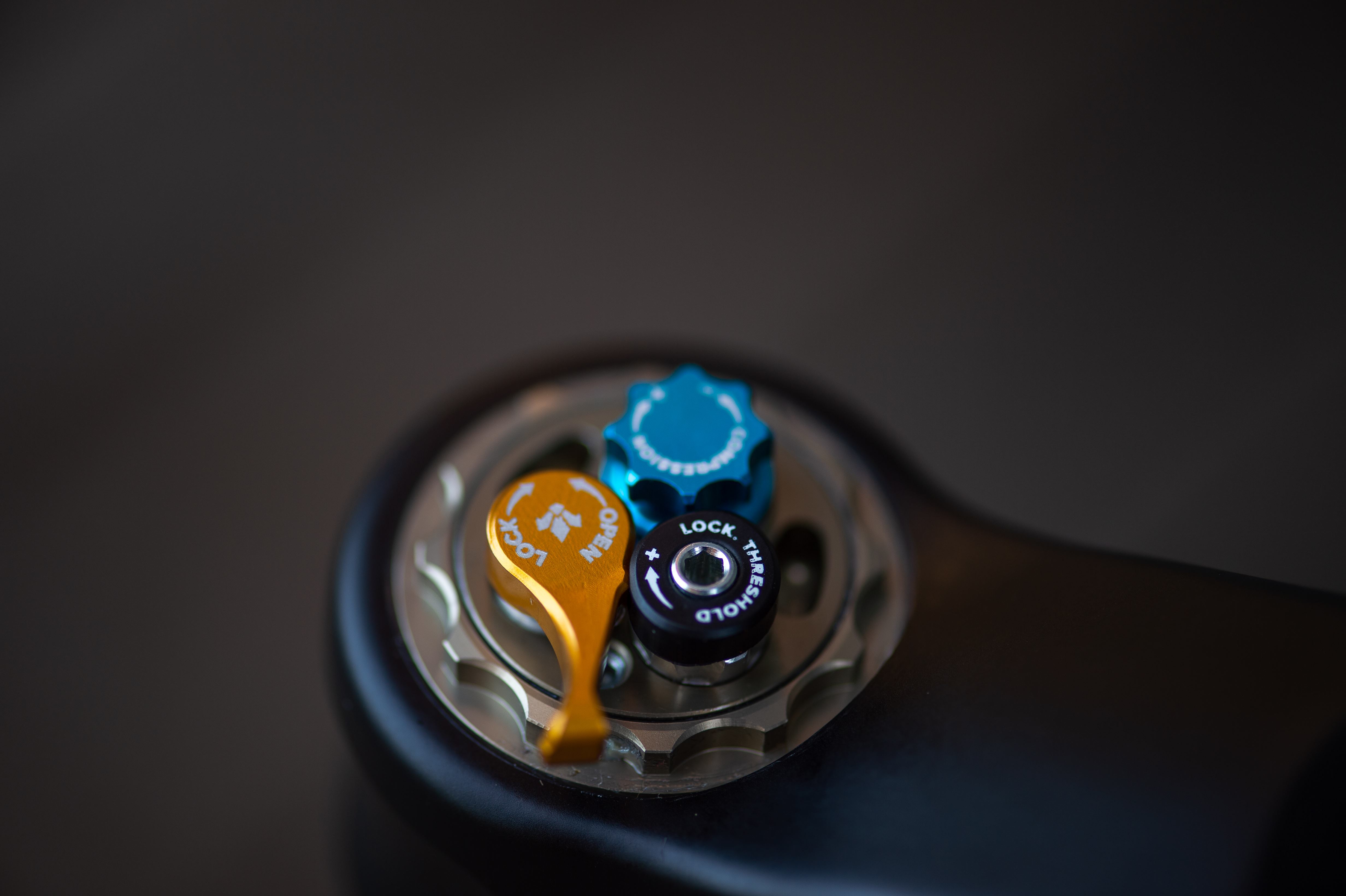Read our definitive techno-pedia
Got into mountain biking and now lost in a world of jargon and acronyms? Help is at hand with our definitive techno-pedia.
>>> MBR Trail Bike of the Year 2020
A
ABP
Active Braking Pivot — Trek’s suspension design that places the seat stay pivot concentric with the rear axle. ABP helps prevent the rear brake impeding the suspension action.
Aheadset
Dia Compe’s threadless steerer/headset system that is now commonplace on all bicycles.
Air can
Short for the air canister on an air sprung rear shock.
Anti squat
Geometric configuration of the suspension to control squatting under acceleration.
Axle to crown height
The true height of a fork, measured from the dropout centre to the top of the fork crown.

Wheels Manufacturing Eccentric BB for PF30 and BB30
B
BB30
Oversized bottom bracket and crank standard.
BCD
Bolt circle diameter of the chain rings. The most common sizes on mountain bikes being 104/64mm for 4 bolt and 110/74mm for five bolt spiders.
Bob
Pedalling induced suspension compression.
Bottom out
Full compression of the suspension. Often accompanied by a metal on metal knock. Bottoming regularly usually means that the spring rate is too low.
Brain
Specialized’s inertia valve suspension technology.
Brake jack
Negative effect of braking on the rear suspension. Stiffening of the rear suspension under braking, dramatically reducing its ability to absorb bumps
Bushing
Plain bearing or sleeve of material for rotary applications. Found in shock eyelets, suspension links and telescopic forks.
Butted
Having variable thickness — usually in reference to frame tubing or spokes.

C
Cartridge bearing
A self-contained bearing assembly with inner and outer races, ball bearings and seals.
Cassette
Rear cog assembly, which slides onto the freehub body.
Cavitation
Phenomenon in dampers when a pressure differential causes the damping fluid to temporally vaporise, leading to inconsistent damping.
Centerlock
Shimano’s splined disc rotor/hub interface.
Chain device
Any system for keeping the chain in place.
Clipless pedals
Misleading term for SPD type pedals i.e. without toe clips. However, flat pedals are also clipless.
Compression damping
Damping created when the wheel hits a bump and compresses the suspension. High-speed compressions are square edge hits like roots and rocks, low-speed compressions are generated by rolling terrain or rider inputs from body movements and pedalling.

D
Damping
The dissipation of energy from a dynamic system, usually in the form of a hydraulic damper.
Detent
An adjuster click.
Dive
Compression of the front suspension under braking. Increasing the sping rate or low-speed compression damping helps combat diving.
Dot
Department of transport rated brake fluid. Usually Dot 4 or 5.1 for mountain bike brakes.
Driveside
The right-hand side of the bike i.e. with the drivetrain.
Dual crowns
Any fork with two crowns. Often called triple clamps, because each stanchion is camped at two points and the lower leg also clamps the hub axle.
Durometer
A measure of the hardness, usually in reference to tyre rubber.
DW-Link
Dave Weagle’s twin link suspension design.
E
Emulsification
When oil and gas mix in a damper (shock), causing inconsistent damping.
F
Falling rate
The force required to compress the suspension decreases as you move through the travel.
Faux-bar
Any four bar suspension design with a fixed main pivot.
FIT
Fox Isolated Technology. Closed damper design that eliminates aeration of the damping fluid.
Fork rake
Terminology for the amount by which the front axle is offset from the steering axis.
Frustum
The geometric name given to all of the tapered head tube standards.
FSR
Future Shock Rear: Specialized’s four-bar rear suspension design.
Full sus
Any bike with suspension front and rear. Short for full suspension or fully suspended.

G
Geometry
The geometric parameters of a bicycle that determine its handling.
GripShift
Sram’s lightweight twist grip shifters.
H
HammerSchmidt
Sram’s two-speed planetary-geared crankset.
Hardtail
Any bike with front suspension and a rigid frame.
Head tube
The part of the frame that carries the headset bearings and front fork.
Hollow Tech
Shimano’s two-piece hollow crank design and external bottom bracket standard.
Horst Link
The chain stay pivot on a four bar suspension design. Named after its inventor, Horst Leitner.
Hydroforming
A process were high pressure fluid is used to form complex tubing profiles.
I
Instant centre
Instantaneous centre of rotation. Basically, a virtual pivot.
ID
Internal Diameter.
Inverted forks
Opposite to conventional forks, so you have the stanchions below the upper tubes. Also called upside-down forks.
ISCG
International Standard Chain Guide mount: A standardised configuration for the three bottom bracket tabs and corresponding holes in a chain device..
ISM
Inter Spoke Milling. A process introduced by Mavic for removing excess rim material between spoke holes.
J
J-shaped axle path
Any axle path that is initially rearward than goes vertical.
K
Kevlar bead
Lightweight, folding alternative to a tyre’s wire bead.

L
Layback
The amount of offset a seatpost head has.
Leverage ratio
Direct relationship between wheel and shock travel. So a 6in travel bike with a 2in stroke shock has a 3:1 leverage ratio. It is the mechanical advantage of the rear wheel on the shock. It’s typically 3:1 on a trail bikes but some designs with long stoke shocks can be as low as 2:1.
Linear rate
The force required to compress the suspension is constant.
Linkage
A series of mechanical levers designed to change the leverage on the shock as the suspension compresses.
Lock-out
Any mechanism to switch the suspension off, by locking it in the fully extended position.
Lower legs
Also called fork lowers or lower casting.

M
Maestro
Giant Bicycles’ twin-link suspension design.
Maxle
Bolt-through quick release system from RockShox.
MCU
Micro Cellular Urethane bumpers also know as elastomer springs.
Mech
Interchangeable with derailleur, so you have a rear mech.
Mechanical discs
Disc brakes with cable, rather than hydraulic actuation.
Mineral oil
Synthetic fluid used in Shimano hydraulic disc brakes.
Monocoque
One-piece construction commonly used in aerospace engineering.
N
Nipple
Brass or alloy nut used to tension a spoke.
Non-driveside
The left-hand side of the bike, without the drivetrain.
O
OD
Outside diameter.
Open bath
Open bath dampers use the same oil for damping and lubrication, while closed cartridge units have separate damping and lubrication fluids.

P
Pawls
Spring-loaded teeth that engage the ratchet ring in a freehub.
Post Mount
Radial disc brake caliper mount, first introduced by Manitou.
Preload
Pre-compression of a spring, that increases the amount of force required to activate the suspension. Used to adjust the static ride height (sag) of the suspension.
Pull shock
Works in the opposite direction to more commonplace push shocks. So any rear shock where spring resistance and compression damping increase on the pull phase of the stroke.
Q
Q-Factor
A measure of crankset width, taken between the outer most points of the pedal inserts.
QR
Quick Release — Any lever using a cam mechanism for applying a clamping force.

R
Rebound
Suspension movement in extension.
Rebound damping
Hydraulic damping created on the rebound stroke as the suspension extends. Too much rebound damping causes the suspension to get stuck down, too little will have you bouncing up and down like a pogo stick.
Rigid
Without suspension.
Rising rate
The force required to compress the suspension increases as you move through the travel.

S
Sag
The amount by which the suspension compresses under the static weight of the rider and bike. Set by changing the spring rate and adjusting spring preload. Sag varies depending on the application, less for cross-county more for downhill, but it is typically 25-30% of the total travel on a trail bike.
Sealed bearings
Any bearing system with a seal to prevent dirt or water ingress. So, a cup and cone set-up can still be referred to as sealed bearings.
Single crown
A fork with one crown, giving a fixed axle-to-crown height.
Single pivot
Any rear suspension design where the axle path is determined by a fixed pivot.
SIS
Shimano Indexing System.
SPD
Shimano Pedaling Dynamics. Shimano’s revolutionary clipless pedal design.
Singlespeed
Bicycle with only one gear.
Split Pivot
Dave Weagle’s single pivot suspension design with a concentric rear axle pivot. Same concept as Trek’s ABP.
Spring
Any mechanical device that stores energy as it is displaced. Normally air or coil, where air springs are lighter and coil springs are more sensitive.
Spring rate
The amount of weight required to compress a spring by a given amount. So a 300lb/in coil spring requires 300lb to compress it by one inch and 600lb to compress it by two inches. Metric units are kg/mm. The lower the spring rate the ‘softer’ the spring is. Air spring rates are measured in PSI or bar. Heavier riders need higher spring rates.
Sprung mass
Everything on the bicycles that is suspended or isolated from bump forces. Includes the rider, frame and most of the components.
Squat
Rear suspension compression under acceleration.
Stanchions
Upper tubes on a conventional telescopic suspension fork.
STI
Shimano Total Integration.
Stiction
From static friction. Initial resistance in a suspension system created by seals, bushings, bearings or lack of lubrication. Less is better. Lots can seriously degrade small bump sensitivity.
Swingarm
The connecting structure between the main pivot (or pivots) and the rear axle.
T
Top-out
Full extension of the suspension. Often accompanied by a metal-on-metal knock if there is insufficient rebound damping or no bump stops.
Travel
The amount of suspension movement given in inches or millimetres. XC bikes typically have 80-100mm, Trail bikes have anything from 120 to 160mm while downhill bikes can have up to 250mm.
U
Unsprung mass
Everything on the bicycle that isn’t suspended. Wheels, rotors, fork lowers, the swingarm and a portion of the rear shock make up the unsprung mass. Basically, everything that has to ride up and over the bumps.
UST
Mavic’s Universal System Tubeless.
V
V-brake
Cantilever rim brake.
Variable rate
The force required to compress the suspension varies as you move through the travel.
Virtual pivot
Any suspension design without a fixed pivot. FSR, DW-link, VPP, VPS, Maestro, Zero all have virtual pivots or instant centres.
VPP
Virtual Pivot Point. Patent protected virtual pivot suspension design with counter-rotating links.
W
Weight
Gravitational force action on a given mass.
Wheelbase
Horizontal distance between the front and rear wheel axles.
X
X12
The 12x142mm rear hub and dropout standard from Syntace.
Y
Yumeya
Shimano’s ultra high-end aftermarket upgrade kit for previous XTR.

Z
Zero Suspension System
Mondraker’s twin-link rear suspension design with floating shock.





